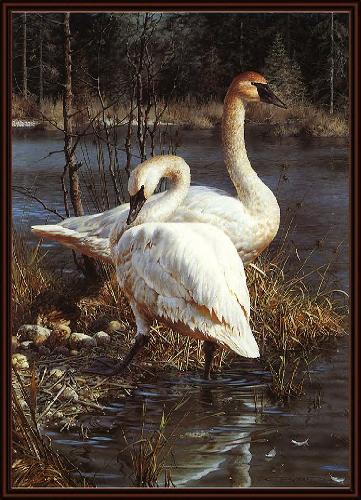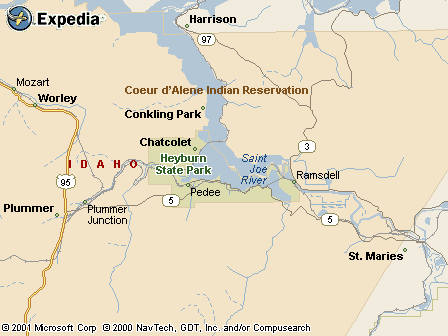|
|
Canku Ota |
|
|
(Many Paths) |
||
|
An Online Newsletter Celebrating Native America |
||
|
November 3, 2001 - Issue 48 |
||
|
|
||
|
Students Dig in During Tribe's Water Potato Roundup |
||
|
by Benjamin Shors-Staff Writer Spokesman Review-October 27, 2001 |
||
|
White Elegance-Trumpeter Swans by Carl Brenders |
 HEYBURN
STATE PARK, Idaho _ The students tramped across the swampy flats and dug through the mud with their hands. HEYBURN
STATE PARK, Idaho _ The students tramped across the swampy flats and dug through the mud with their hands.After several minutes, one boy held up his prize -- a small aquatic tuber that looked like a severed thumb. "Found one," he yelled to classmates, "we aren't going hungry tonight." Thirty middle school students from the Coeur d'Alene Tribal School fanned out across Hawley's Landing on Friday in search of water potatoes -- a starchy root that has fed members of the Coeur d'Alene Tribe for generations. Friday was Water Potato Day, a cultural ritual celebrating one of the most important foods gathered by the tribe. The last harvestable crop before the winter months, the tuber -- "sqigwts" in the tribe's language -- is considered a delicacy unique to the tribe. The potatoes -- once the size of baseballs -- now are acorn-sized, the downstream victims of mining waste that has drained into the lake, according to some tribal members. Many Coeur d'Alene members no longer dig for potatoes in the shallow lateral lakes of the Coeur d'Alene River because of mining pollution. The U.S. Environmental Protection Agency's $359 million cleanup, which was proposed on Wednesday, does not include Lake Coeur d'Alene, where heavy metals in water are twice the federal safety limit for aquatic life. Trumpeter swans along the waterways die of lead poisoning every year, which biologists attribute to toxic metals in contaminated potatoes. Hawley's Landing, a broad mudflat in Heyburn State Park, is one of the few areas around the lake where tribal members still harvest potatoes. Traditionally, young girls were sent barefoot into the flats to dig in the mud with their toes. "It's gone on since time immemorial," said Rodney Frey, a University of Idaho cultural anthropologist whose book "Landscape Traveled by Coyote and Crane: The World of the Schitsu'umsh" hits bookstores next week. "It anchors the tribe to the lake." On Friday, students had the modern advantage of hip waders. But it's not easy work, as 11-year-old William Parr discovered. "I got stuck in the mud and I got dirty," Parr said. "But I'd probably get used to it." Students will prepare a water potato stew with tomatoes, onions and meat Monday. The water potato, which is slightly more bitter than the average spud, typically requires extra boiling to prepare. Or they can be popped in the microwave or fried in a skillet. "They're better than regular potatoes," said Jordan Goddard, 12, who found two small, muddy potatoes. Teachers mixed the harvesting with tribal legends and plant identification walks. "One hundred years ago, this would have been their classroom," said Suzi Friedlander, a speech and language pathologist at the school. "You can't learn everything in a school building." |
|
|
|
|
||
|
|
||
| Canku Ota is a free Newsletter celebrating Native America, its traditions and accomplishments . We do not provide subscriber or visitor names to anyone. Some articles presented in Canku Ota may contain copyright material. We have received appropriate permissions for republishing any articles. Material appearing here is distributed without profit or monetary gain to those who have expressed an interest. This is in accordance with Title 17 U.S.C. section 107. | ||
|
Canku Ota is a copyright © 2000, 2001 of Vicki Lockard and Paul Barry. |
||
|
|
|
|
|
The "Canku Ota - A Newsletter Celebrating Native America" web site and its design is the |
||
|
Copyright © 1999, 2000, 2001 of Paul C. Barry. |
||
|
All Rights Reserved. |
||

